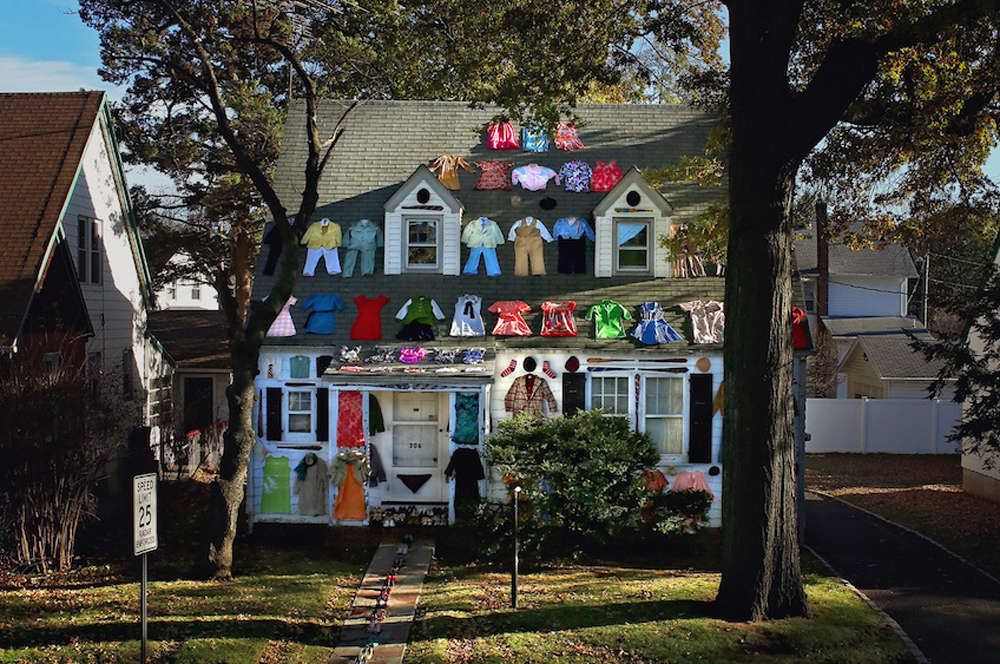Some time ago in their commercial work, the filmmaking siblings Elan and Jonathan Bogarín were given commissioned by the Whitney Museum of Art, during which the head of the museum told them, “One of the essential elements of how to deal with art is just look and look and look again.” These words resonated with the two when they were confronted with the belongings of their grandmother who had passed on.
“And she was very right,” says Elan. “If you take something that’s very ordinary and something that you’ve seen something a million times and just pause, all of a sudden, everything starts to shift and this thing you’ve seen a million times – your own bedroom, your own house, your own world that you see every day, it starts to transform and become this unbelievably beautiful and often magical thing right in front of you. But you have to tell yourself and teach yourself to see it differently.”
It’s a vision that the Bogaríns extend to “306 Hollywood,” their tribute to their grandmother Annette Ontell, who left behind a language with which to tell her story, between clippings from fashion magazines for her work as a designer and receipts for everything she ever purchased, thanks to having an accountant for a husband. But the two find an even grander poetry in Annette’s life as they go through her things with their mother, who struggles at first to see what they do as they put clothes and knick-knacks into separate piles to either discard or keep. It becomes obvious that Elan sensed there was always a larger story to tell, having filmed interviews with Annette towards the end of her life while she was in film school, and after previously teaming with her brother to make “Invisible Murals,” recounting the history of one side of their family from Venezuela through the demise of an oil boom town as mythologized in local paintings and stories, the two open up Annette’s humble home in Hillside, New Jersey to discover a treasure trove that feels as if it’s a vital part of our collective history, though the value of it rests on the filmmakers there to capture it.
Although the Bogaríns go so far as to take a small-scale replica of their grandmother’s house around the community, placing it in the aisles of grocery stores and on the streets of other neighborhoods (working over a year-and-a-half to get the details just right for what’s just a small segment of the film), “306 Hollywood” becomes a more amorphous trojan horse in terms of exploring how history is made and who or what determines as valuable enough to be passed on to future generations while also acting as a tender portrait of Annette, who maintained a mostly quiet existence of a housewife yet her varied interests and insights can be seen in what she left behind around her house as well as in Elan’s filmed interviews. To honor a life lived fully, the Bogaríns use dazzling montage, dance sequences and visits to Sleepy Hollow, New York, to the John D. Rockefeller Archive, and Rome, where Jonathan studied art history, to collapse time and space so as to see it clearly and vividly as one continuum in which Annette’s presence was at once small but significant.
Recently in Los Angeles for the film’s theatrical rollout following its premiere earlier this year at the Sundance Film Festival, Elan and Jonathan Bogarín spoke about how they set about making “306 Hollywood” as they grieved for their grandmother, finding right grammar with which to tell the story and the surprises that came along the way.
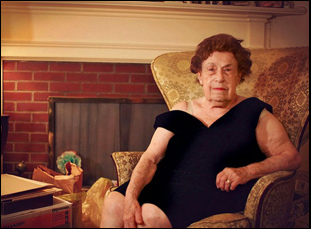 After your grandmother’s passing, your mom understandably wants to get rid of everything as quickly as possible and sell the house after your grandmother passes. Did you have a scramble to keep everything for the film?
After your grandmother’s passing, your mom understandably wants to get rid of everything as quickly as possible and sell the house after your grandmother passes. Did you have a scramble to keep everything for the film?
Elan Bogarín: What happened is we were hit with a very real decision. As anyone who knows with a house or an apartment, it’s not the cheapest thing to [keep up], so we had to decide what are we going to do next and we had a very short window [to decide] are we keeping this? If we’re getting rid of it, we need to move forward and sell it. And if we’re not, we’re going to have to make a very distinct plan of what happens.” So we really needed to get [our mom] onboard to say, “We’re keeping this. We’re [making] the completely illogical decision and say, ‘let’s move forward [with the movie].’” It was definitely the come to Jesus moment — for us Jews [laughs].
Jonathan Bogarín: I think she knew that we were doing something. She knew that we were filming. But I don’t think she quite understood the way that we thought about it. So the moment [when we tell her] this “It’s an archeological dig,” it’s like, “You’re nuts. You’re crazy.” And when anybody loses a loved one, they’re left with something and everybody has to figure out what to do with it, and it was the extreme nature of what we chose to do with it — to transform and to think of it as if [the house] was an ancient civilization and excavate,” was really the moment [of surprise for her].
In order to organize a shoot, are your ideas fully formed before going through your grandmother’s things or does pulling stuff out inform what kind of film you’re going to make?
Elan Bogarín: We definitely made this in an improvisatory manner.
Jonathan Bogarín: We had the goal of making a magical realist documentary from before we started, to find the language to tell an ordinary person’s story and make them feel extraordinary because that’s what we felt from our grandmother. However, the question of how to do it is what was improvisatory. It was something we discovered as we went along. Once we had the idea of excavating and using the idea of mythology to tell a real person’s story, then we went down the rabbit hole and it became a true excavation where we learned all sorts of things throughout the process.
Elan Bogarín: When we went through her interviews and her [other] stuff, it was a completely new way to learn about life and learn about new ways how to die. We found this entire archive of her old age in the tapes that we hadn’t ever watched again after we’d filmed them with her, and all of a sudden, you have this person that you knew so well comes out of the past and is able to teach you how to look at life from the end of life, looking back. So the way that we looked at it, our grandmother is sort of an unwitting philosopher. She had the techniques and the understanding of life to get it down to its essential meanings in a way that was [different] than how I think a lot of us live our day to day life. It was a reminder to bring it down, simplify and understand there’s only so many values that really stay with you and are what actually wrap your life up when you get towards the end.
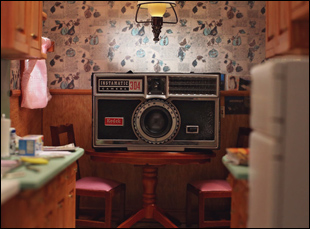 Just the fact that there are these audio tapes of a lot of seemingly mundane moments, did you grow up with a strong tradition of audio and video recording in your family?
Just the fact that there are these audio tapes of a lot of seemingly mundane moments, did you grow up with a strong tradition of audio and video recording in your family?
Jonathan Bogarín: Even more than documenting our family, it’s more that we grew up around artists. Our grandmother was a clothing designer, our mother was involved in the arts and our father was making avant garde films during the ‘70s — and some of that footage actually made it into “306 Hollywood,” so there was always this sense of looking at life through a creative lens was always important and this idea of creating images — finding ways to represent reality — was something that we grew up with. We didn’t know about the recording from 1970 until we started going through the stuff. That was a discovery.
The piece of interview footage that stuck with me is a moment that Elan shoots where your grandmother puts on some of the dresses she designed. How did that moment come in?
Elan Bogarín: That was one of the most essential linchpins to the footage — for us, that one extended clip of her trying on dresses represents so many different pieces of what we were learning from her – what does it mean to be a woman? How do we look at mortality? She was willing, honest and brave enough to show what does your body look like over time – how do you deal with both the fear of it as well as the fact that you realize this is who I am? This is where it puts me and this is where I can be. And seeing that in real time, especially years after it happened, was one of the most meaningful things to return to because she’s teaching you that even if you’re scared of what time results in, here you are – accept that this is exactly where you are in this moment and that’s okay. The journey that she goes on in that clip represents all of the positives and negatives of that fear — of the experience of time and aging and mortality — so that actually became one of the crucial components of [the film], saying we’re talking about time and the fact that all of us are on that exact same arc and the trajectory. You can’t hide from time.
Were the larger ideas of history there from the start of this?
Jonathan Bogarín: Our background is all over the place. We’re visual artists, but we always grew up interested in art history, literature and history, so these are all different things that inform the way that we look at making any project. And as we began investigating our grandmother’s life, we found that there were all these questions. There was this idea of who’s written into history and why is our grandmother’s stuff [considered] junk and why is someone else’s stuff in a museum? That was what led us to the Rockefeller Archive. You start feeling that sometimes grandma is present and sometimes you feel she’s absent, so you’re like, “Well, what would a scientist have to say about this?” Or a religious person? And we began to follow those different paths in order to find the ways in which those larger areas of human inquiry, the larger ways we tell stories about humanity are actually relevant to my grandmother, your grandmother and the next person’s grandmother.
Elan Bogarín: And this film is about time. This film is us looking at the trajectory of one person’s life, the trajectory of a family and what happens in the time after someone passes. It’s a snapshot of multiple time cycles.
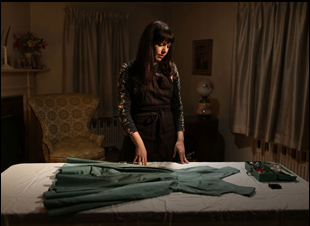 Jonathan Bogarín: Yeah, in the house we found 100 years and we have our grandmother talking about the 93 years of her life. It’s 20 years in our lives. And we actually go back to ancient Rome, so it’s 2500 years into the past, and we really wanted to show how an individual person’s life can make you trip out on time in general. We also always wanted to create metaphors for every single emotion and every single idea that’s in the film, so there’s all this time that has passed [in the film], but we wanted to find ways to create a visual metaphor to talk about that and connect it to our characters, connect it to our grandmother and connect it to our characters in the film, so you see all of our experiences of getting older and older.
Jonathan Bogarín: Yeah, in the house we found 100 years and we have our grandmother talking about the 93 years of her life. It’s 20 years in our lives. And we actually go back to ancient Rome, so it’s 2500 years into the past, and we really wanted to show how an individual person’s life can make you trip out on time in general. We also always wanted to create metaphors for every single emotion and every single idea that’s in the film, so there’s all this time that has passed [in the film], but we wanted to find ways to create a visual metaphor to talk about that and connect it to our characters, connect it to our grandmother and connect it to our characters in the film, so you see all of our experiences of getting older and older.
Elan Bogarín: We were interested in discussing issues that are difficult and often challenging, whether that be time and mortality or grief and loss. We wanted to dive straight into things that affect every single one of us, but at the same time is often not generally talked about in our society, and in almost every culture in the world, they have used myth and magical realism to discuss challenging life changing events like birth, death and coming of age because you’re dealing with the fact that it’s challenging, but you want to give a language to make it approachable, where we can say, “Okay, it may be too much for me to talk about for me personally, but I’m going to give myself a story so I can understand.” So we adopted those languages and basically used that for the imagery, for the imagination in order to discuss this difficult topic.
Jonathan Bogarín: There’s also an element that everyone in our film was dead. [laughs] So all of the things [we were discussing] were inanimate and films are about motion and image, so basically, we had to figure out what [stories] will lend itself to being an image. That was actually part of the criteria because everything tells a story – that chair tells a story, that garment tells a story _ but the question is how can we make it alive, to give it the meaning that we had in our grandmother’s life and the meaning it had for us as her grandchildren, making sense of what remained.
Just as filmmakers, is it exciting to stage something like a dance sequence?
Elan Bogarín: It was incredible. Remember, no matter what, documentaries are films. They’re coming out of cinematic history as much as it’s coming out of [our collective] history and for us, it was this unbelievable experience of taking your day-to-day life and thinking, we don’t just look at our day-to-day life in interviews and vérité. We look at it in how we viscerally experience something, and we wanted to take that visceral metaphorical experience that we’re living and bring that to life. We could do that with something like that dance. We could do that with something like the catalogs [of our grandmother’s things] that we constructed. Our goal was to make what we were imagining and perceiving, our literal subjective experience as part of what is true.
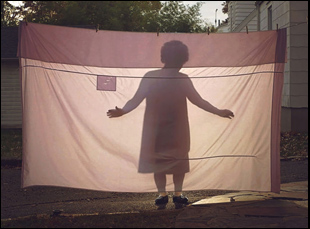 Jonathan Bogarín: Yeah, so much of that had to do with finding influences way outside of the documentary field. We’re just big nerds, so with the dance sequence, we started studying Busby Berkeley and the films from the 1930s, and there were times we were studying ghost stories or Eastern European animation, or looking at Natural History museums and the way they organize [artifacts] or contemporary photography. So there’s all these different influences that are not traditionally in nonfiction and we just said, “Let’s just bring this all in so we have something as rich and beautiful and bold a language as possible to talk about something that a lot of people don’t think is all that important.” [People are apt to say] “This is just some lady,” but that’s the whole point – it’s like the lady is the whole world when it’s her world.
Jonathan Bogarín: Yeah, so much of that had to do with finding influences way outside of the documentary field. We’re just big nerds, so with the dance sequence, we started studying Busby Berkeley and the films from the 1930s, and there were times we were studying ghost stories or Eastern European animation, or looking at Natural History museums and the way they organize [artifacts] or contemporary photography. So there’s all these different influences that are not traditionally in nonfiction and we just said, “Let’s just bring this all in so we have something as rich and beautiful and bold a language as possible to talk about something that a lot of people don’t think is all that important.” [People are apt to say] “This is just some lady,” but that’s the whole point – it’s like the lady is the whole world when it’s her world.
Elan Bogarín: One thing that we’ve really been conscious of is the home is generally looked at as a feminine space that has usually been left out of history, and with a woman like our grandmother, she was someone who was remarkable in the way she lived her life, but not necessarily in her career. So it was very, very important for us to look at those elements that are traditionally undervalued, overlooked and just not perceived as an important part of any history and actually weave that into saying every single one of us is shaped by our families and shaped by our places that determine how we view our society. [We wanted to] look at that for a moment and recognize that these are the building blocks for our bigger world and let’s take a moment and realize this is not just a small story. This small story equates to our entire reality and say, “Wait a minute. This is a worthwhile story here.”
Both as personal keepsake for yourselves and a movie you’re sharing with audiences, what’s it been like taking it out into the world?
Jonathan Bogarín: In terms of the personal component, the process of making the film was a way of dealing with grief. It was processing the loss of someone we loved very dearly and incorporating that loss into our present lives and turning it into a way to move forward and to keep living. In terms of other people, we’ve had so many people come up to us after screenings going, “This reminds me of my mother or my grandfather or my grandmother” and that’s a remarkable experience because you realize whether they come from the same background or not is irrelevant. The point is they have someone that they loved and through the film, they were able to see the importance and the value in their experience and in the lives of the people that they cared about, so that’s a way to connect. We think of [the film] almost as a guide for grief, a guide for valuing the people that we care about, and a guide for including us all in history.
“306 Hollywood” is now playing in Los Angeles at the Laemmle Royal and the Encino Town Center. A full schedule of theaters and dates is here.




